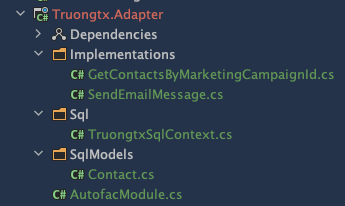2. Adapter Layer
The Business layer mentioned before contains a list of interfaces to connect to other external dependencies (external services, database storage). It doesn’t care what database system to use or what protocol the external services need. All those logic will be implemented in this Adapter layer.

An implementation may look like this
public class GetContactsByMarketingCampaignId : IGetContactsByMarketingCampaignId
{
private readonly IMapper _mapper;
public GetContactsByMarketingCampaignId(IMapper mapper)
{
_mapper = mapper;
}
public IList<Business.Contact> Execute(int marketingCampaignId)
{
// get from Redis cache and then fallback to SQL
var contacts = GetFromRedis(marketingCampaignId) ?? GetFromSql(marketingCampaignId);
// use AutoMapper to map back to Business model
return mapper.Map<IList<Business.Contact>>(contacts);
}
private IList<SqlModels.Contact> GetFromRedis(int marketingCampaignId)
{
// logic to get from redis here
...
}
private IList<SqlModels.Contact> GetFromSql(int marketingCampaignId)
{
// logic to get from sql here
...
}
}
Here are something to notice about this layer
- It abstracts all the complex logic to connect to external dependencies. The main business logic doesn’t have to care whether it is reading from a cache server or a persistent storage. This makes testing your main business easier and isolate the cross-cutting concerns.
- You can easily swap the storage layer, introduce any caching layer that you want without affecting the main business logic. We applied this to migrate from Rethinkdb to MSSQL database.
- AutoMapper is essential. Each layer should work with its own set of models instead of relying on the other layer’s components.
- It requires integration test effort, where you have to spin up your local database and all the
related services. Of course, based on the Testing pyramid, there should be fewer test cases here
compare to the Business layer
You also need to do more setup for testing. Luckily, Autofac and Moq play nicely together.
// XUnit example
public class GetContactsByMarketingCampaignIdTest : IDisposable
{
private readonly AutoMock _mock;
private readonly TruongtxSqlContext _dbContext;
public GetContactsByMarketingCampaignId()
{
_mock = AutoMock.GetLoose(builder => builder.RegisterModule<Truongtx.Adapter.AutofacModule>());
_dbContext = _mock.Create<TruongtxSqlContext>();
}
[Fact]
public async Task FeedbackContentIsNull()
{
// Prepare
var marketingCampaignId = 1;
var contact = new SqlModels.Contact();
_dbContext.Contacts.Add(contact);
_dbContext.SaveChanges();
// Act
var handler = _mock.Create<GetContactsByMarketingCampaignId>();
var res = handler.Execute(marketingCampaignId);
// Assert
res.Should()..... // I use FluentAssertion
}
public void Dispose()
{
// Clean up data here
}
}

